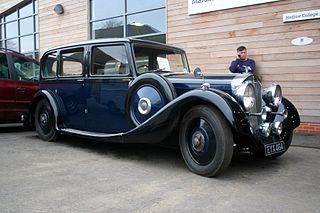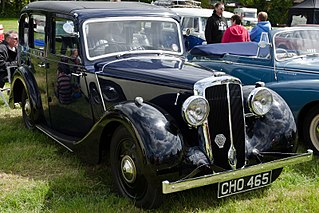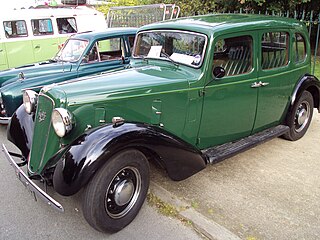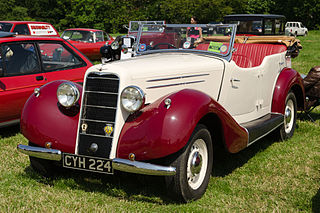The Lanchester Motor Company Limited was a British car manufacturer in active trade between 1899 and 1955. Though the Lanchester Motor Company Limited is still registered as an active company and accounts are filed each year, the marque has been dormant since. As of 2014 it is marked as "non-trading".

The Daimler Conquest is an automobile which was produced by The Daimler Company Limited in the United Kingdom from 1953 to 1958. Based on the Lanchester Fourteen, the Conquest replaced the Daimler Consort. Sales were affected by increasing prices and by the fuel shortage caused by the Suez Crisis, and production ended by January 1958, before a replacement model was in production.

Autovia was a short lived brand of British car from Coventry existing from 1935 to 1938 with production starting in January 1937. The venture was ambitious and even included setting up a school for chauffeurs. The cars were expensive and it was a market sector well served by other companies. 44 cars were made.

The Singer Bantam is a car which was produced by Singer from 1936 to 1939. It was the first model from Singer to have an all-steel body, by Pressed Steel Company. It was offered as a new economy model at the 1935 Motor Show in London, replacing the earlier Singer Nine series.

The Rover 10 was a small family car from the British Rover car company produced between 1927 and 1947.

The Rover Meteor was a short-lived 2½-litre or 2-litre medium-sized car made by The Rover Company Limited of Meteor Works Coventry. The new 2½-litre model was announced in mid-February 1930 to supplement Rover's Light Twenty which used the same engine and essentially the same chassis.

The Singer Roadster is a nine tax horsepower open 2/4-seater sports-tourer automobile manufactured by Singer from 1939 until 1955. It was launched in March 1939 as an open version of Singer's Bantam saloon and using many Bantam parts.

The Daimler Regency series was a luxury car made in Coventry by The Daimler Company Limited between 1951 and 1958. Only an estimated 49 examples of the 3-litre Regency chassis were made because demand for new cars collapsed just weeks after its introduction. Almost three years later in October 1954, a lengthened more powerful Regency Mark II (DF304) was announced but, in turn, after a production run of 345 cars, it was replaced by the very much faster, up-rated One-O-Four (DF310), announced in October 1955.

The Austin Light Twelve-Six is a 14 tax horsepower car with a 1496 cc engine that was introduced by Austin in January 1931. It was named by Austin Light Twelve to separate it from the well-established Austin Twelve. The general public then dubbed the original Twelve Heavy Twelve but Austin never used that name. The Light Twelve-Six remained in production until 1936.

The Hillman Fourteen is a medium-sized 4-cylinder car announced by Hillman's managing director Spencer Wilks, a son-in-law of William Hillman, at the end of September 1925. This new Fourteen substantially increased Hillman's market share and remained on sale into 1931. During this time it was the main product of the company.
The Rover 16/50 and Rover 16 are mid-sized cars which were produced by Rover from 1926 to 1929 and non-continuously from 1936 to 1947 respectively.

The Lanchester Ten and Lanchester Eleven were sold by The Lanchester Motor Company Limited from the Ten's announcement in September 1932 until 1951. Quite different from previous Lanchesters, the Ten was the second of Lanchester's new owner's new Daimler-linked Lanchester range. The names Ten and Eleven referred to the engine's rating for the annual tax and did not relate to the engine's power output.

The Lanchester Fourteen Roadrider is a six-cylinder automobile introduced by the Lanchester Motor Company in the beginning of September 1936. It was named "Roadrider" for its special suspension features, and billed as the lowest-priced six-cylinder Lanchester ever offered. This car replaced the previous 12 hp Light Six model with a larger six-cylinder engine again in the Lanchester Eleven chassis and body.

The BSA Scout is a small open two-seater front-wheel drive car, manufactured and sold by subsidiaries of The Birmingham Small Arms Company Limited, launched at the beginning of April 1935. On account of its front-wheel drive and low centre of gravity it was said to be remarkably stable taking corners in safety which would be impossible with a normal design. This new addition to the range of small open cars for young motorists was intended to further embellish BSA's reputation for sound design, robust construction and complete reliability.
The Rover Fourteen was a medium-sized family car and variants produced by the British Rover car company between 1924 and 1948. Civilian automobile production was interrupted in 1940 because of the war, but when the war ended in 1945, the Rover 14 returned to the market and remained available until replaced by the Rover 75 at the beginning of 1948.

The Austin Fourteen is a 1.7-litre saloon that was introduced by Austin in August 1936 and available as a Goodwood saloon—with a fixed or sliding head—or as a Goodwood cabriolet. The body was of steel throughout. Nominally classed by Austin as a Fourteen the actual engine size attracted tax for a 16 horsepower car. The performance of the engine carried over from the Light Twelve-Six proved disappointing and a much smoother revised version with a near 20% improvement in power output was introduced the next year.

The Hillman Wizard 75, Hillman Twenty 70, Hillman Hawk and their long wheelbase variants Hillman Seven Seater and Hillman 80 models were a series of 20 horsepower medium priced 5-7 seater executive cars made by Hillman during the 1930s.

Morris Twelve is a model of Morris car introduced without fanfare in the autumn of 1934 as little more than a larger engined Morris Ten Four for which just another £5 was asked. The chassis and body were of the slow-selling longer wheelbase Ten Six. The engine though awarded a tax rating of 11.98 hp had a cubic capacity of 1548cc compared with Morris's 1292cc (10 hp) Ten Four and 1378cc (12.09 hp) Ten Six.

The Morris Oxford Six is a motor car produced by Morris of the United Kingdom from 1921 until 1926, and again from 1929 until 1935. Initially produced as a straight-six engined version of the Morris Oxford bullnose, the original Oxford Six was the first car produced by Morris with a six-cylinder engine, but proved to be unreliable. The versions produced from 1929 onwards were introduced as a replacement for the Morris Oxford 16/40.

Alvis Silver Crest is a 4 or 5 passenger saloon car or coupé produced by the Alvis Car and Engineering Company between 1937 and 1940. It used advanced technology intended to provide a top speed in excess of 80 miles per hour (129 km/h) and sold at a relatively high purchase price. Announced in mid-August 1937, production ended just before the war when a new-shaped body entered production.





















